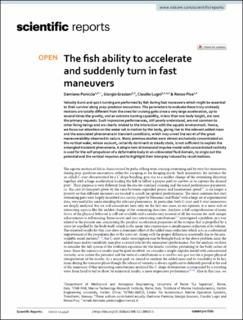| dc.contributor.author | Paniccia, Damiano | |
| dc.contributor.author | Graziani, Giorgio | |
| dc.contributor.author | Lugni, Claudio | |
| dc.contributor.author | Piva, Renzo | |
| dc.date.accessioned | 2023-02-01T13:50:25Z | |
| dc.date.available | 2023-02-01T13:50:25Z | |
| dc.date.created | 2022-05-04T09:51:25Z | |
| dc.date.issued | 2022 | |
| dc.identifier.citation | Scientific Reports. 2022, 12 (1), . | en_US |
| dc.identifier.issn | 2045-2322 | |
| dc.identifier.uri | https://hdl.handle.net/11250/3047772 | |
| dc.description.abstract | Velocity burst and quick turning are performed by fish during fast maneuvers which might be essential to their survival along pray–predator encounters. The parameters to evaluate these truly unsteady motions are totally different from the ones for cruising gaits since a very large acceleration, up to several times the gravity, and an extreme turning capability, in less than one body length, are now the primary requests. Such impressive performances, still poorly understood, are not common to other living beings and are clearly related to the interaction with the aquatic environment. Hence, we focus our attention on the water set in motion by the body, giving rise to the relevant added mass and the associated phenomena in transient conditions, which may unveil the secret of the great maneuverability observed in nature. Many previous studies were almost exclusively concentrated on the vortical wake, whose account, certainly dominant at steady state, is not sufficient to explain the entangled transient phenomena. A simple two-dimensional impulse model with concentrated vorticity is used for the self-propulsion of a deformable body in an unbounded fluid domain, to single out the potential and the vortical impulses and to highlight their interplay induced by recoil motions. | en_US |
| dc.language.iso | eng | en_US |
| dc.publisher | Springer Nature | en_US |
| dc.rights | Navngivelse 4.0 Internasjonal | * |
| dc.rights.uri | http://creativecommons.org/licenses/by/4.0/deed.no | * |
| dc.title | The fish ability to accelerate and suddenly turn in fast maneuvers | en_US |
| dc.title.alternative | The fish ability to accelerate and suddenly turn in fast maneuvers | en_US |
| dc.type | Peer reviewed | en_US |
| dc.type | Journal article | en_US |
| dc.description.version | publishedVersion | en_US |
| dc.source.volume | 12 | en_US |
| dc.source.journal | Scientific Reports | en_US |
| dc.source.issue | 1 | en_US |
| dc.identifier.doi | 10.1038/s41598-022-08923-5 | |
| dc.identifier.cristin | 2021299 | |
| dc.relation.project | Norges forskningsråd: 223254 | en_US |
| cristin.ispublished | true | |
| cristin.fulltext | original | |
| cristin.qualitycode | 1 | |

